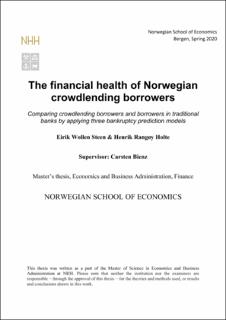The financial health of Norwegian crowdlending borrowers : comparing crowdlending borrowers and borrowers in traditional banks by applying three bankruptcy prediction models
Master thesis
Permanent lenke
https://hdl.handle.net/11250/2678954Utgivelsesdato
2020Metadata
Vis full innførselSamlinger
- Master Thesis [4372]
Sammendrag
The purpose of this thesis is to examine whether companies obtaining loans at Norwegian
crowdlending platforms are more likely to default than companies obtaining loans in traditional
Norwegian banks. Crowdlending, the concept of lending directly from large groups of investors
through a digital platform, has experienced an explosive growth in Norway and worldwide over
the last years. Despite this, research regarding this topic is limited. To the best of our
knowledge, this is the first study to examine the financial health of Norwegian crowd
borrowers.
In our empirical study, we use three proven models for prediction of bankruptcy and analyze
whether Norwegian crowd borrowers’ credit quality is different than that of regular Norwegian
borrowers. The analysis is conducted on a dataset constructed from manual collection of
Norwegian crowd borrower information from the three Norwegian crowdlending platforms
Monner, FundingPartner and Kameo. To create an approximately randomized experiment with
suitable comparable traditional borrowers we applied the matching approach of Coarsened
Exact Matching.
Based on our analysis, there is not enough evidence to suggest that Norwegian crowdlending
borrowers are riskier than borrowers in traditional banks. Although the mean and median credit
scores of crowd borrowers are generally worse than those of the regular borrowers, thus
suggesting a difference in credit quality between the groups, these differences prove to be
statistically insignificant.
